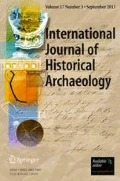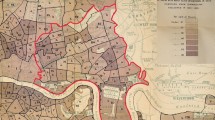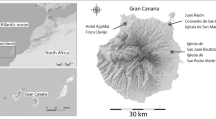Abstract
This paper explores the dentition of individuals excavated from two post-medieval London cemeteries. Individuals from Chelsea Old Church, a middle-class group, and St. Bride’s lower churchyard, a working-class group, were selected and studied. The relative dental status of each group was explored by determining the prevalence of individuals and teeth affected by dental caries. The overall dental status of both class groups was found to be poor; diet was the most likely causative factor. Access to cariogenic foods such as sugar and refined flour likely affected individuals’ dental status regardless of their social class.



Similar content being viewed by others
References
Biggs, B., King, L., Basu, S., and Stuckler, D. (2010). Is wealthier always healthier? the impact of national income level, inequality, and poverty on public health in Latin America. Social Science & Medicine 71: 266–273.
Boyle, A. and Keevil, G. (with a contribution by Cox, M., Kneller, P. and Haslam, R.) (1998). “To the praise of the dead, and anatomie”: the analysis of post-medieval burials at St. Nicholas, Sevenoaks, Kent. In Cox, M. (ed.), Grave Concerns: Death and Burial in England 1700–1850, Council for British Archaeology, York, pp. 85–99.
Braudel, F. (1981). Civilization and Capitalism, 15th to 18th Century, Volume I: The Structures of Everyday Life, Harper and Row, New York.
Brickley, M., Buteux, S., Adams, J., and Cherrington, R. (1999). The Cross Bones Burial Ground, Redcross Way, Southwark, London. Archaeological excavations (1991–1998) for the London Underground Limited Jubilee Line Extension Project, Museum of London, London.
Brickley, M., Buteux, S., Adams, J., and Cherrington, R. (2006). St. Martin’s Uncovered: Investigations in the churchyard of St. Martin’s-in-the-Bull Ring, Birmingham, 2001, Oxbow, Oxford.
BFS (British Fluoridation Society). (2012). One in a million: the facts about water fluoridation. 3rd ed. http://www.bfsweb.org/onemillion/04%20One%20in%20a%20Million%20-%20The%20Dental%20Benefits%20of%20Water%20Fluoridation.pdf.
British Medical Association. (2010). New President For The BMA: Sir Michael Marmot. Medical News Today. http://www.medicalnewstoday.com/releases/193848.php.
Brooks, S. T., and Suchey, J. M. (1990). Skeletal age determination based on the os pubis: a comparison of the Ascadi-Nemeskeri and Suchey-Brooks methods. Journal of Human Evolution 5: 227–238.
Brothwell, D. R. (1959). Teeth in earlier human populations. Proceedings of the Nutrition Society 18: 59–65.
Brothwell, D. R. (1981). Digging Up Bones, Natural History Museum, London.
Buckberry, J. L., and Chamberlain, A. T. (2002). Age estimation from the auricular surface of the ilium: a revised method. American Journal of Physical Anthropology 119: 231–239.
Buikstra, J. E. (1977). Biocultural dimensions of archeological study: a regional perspective. In Blakely, R. L. (ed.), Biocultural Adaptation in Prehistoric America, University of Georgia Press, Athens, pp. 67–84.
Buikstra, J. E. (1991). Out of the appendix and into the dirt: comments on thirteen years of bioarchaeological research. In Powell, M. L., Bridges, P. S., and Mires, A. M. W. (eds.), What Mean These Bones? Studies in Southeastern Bioarchaeology, University of Alabama Press, Tuscaloosa, pp. 172–188.
Burt, B. A. (1993). Relative consumption of sucrose and other sugars: has it been a factor in reduced caries experience? Caries Research 27: 56–63.
Cohen, M. N., and Bennett, S. (1993). Skeletal evidence for sex roles and gender hierarchies in prehistory. In Miller, B. D. (ed.), Skeletal Differences and Gender Hierarchies, Cambridge University Press, Cambridge, pp. 273–296.
Connell, B., and Rauxloh, P. (2003). A Rapid Method for Recording Human Skeletal Data, Unpublished Museum of London report, London.
Corbett, E., and Moore, W. J. (1976). Distribution of dental caries in ancient British populations IV: the 19th century. Caries Research 10: 401–414.
Costa, R. L. (1982). Periodontal disease in the prehistoric Ipiutak and Tigara skeletal remains from Point Hope, Alaska. American Journal of Physical Anthropology 59: 97–110.
Cowie, R., Bekvalac, J., and Kausmally, T. (2008). Late 17th- to 19th-Century Burial and Earlier Occupation at All Saints, Chelsea Old Church, Royal Borough of Kensington and Chelsea, Museum of London, London.
Cucina, A., and Tiesler, V. (2003). Dental caries and ante-mortem tooth loss in the Northern Peten area, Mexico: a biocultural perspective on social status differences among the Classic Maya. American Journal of Physical Anthropology 122: 1–10.
Danforth, M. E., Jacobi, K. P., and Cohen, M. N. (1997). Gender and health in the colonial Maya of Tipu, Belize. Ancient Mesoamerica 8: 13–22.
Deerr, N. (1950). The History of Sugar, vol. 2, Chapman and Hall, London.
Drummond, J. C., and Wilbraham, A. (1957). The Englishman’s Food: A History of Five Centuries of English Diet, Jonathan Cape, London.
Eden, F. M. (1797). The State of the Poor: A History of the Labouring Classes in England, J. Davis, London.
Fildes, V. (1986). Breasts, Bottles and Babies: A History of Infant Feeding, Edinburgh University Press, Edinburgh.
Finlay, R., and Shearer, B. (1986). Population growth and suburban expansion. In Beier, A. L., and Finlay, R. (eds.), London 1500–1700: The Making of the Metropolis, Longman, London, pp. 37–59.
Frayer, D. W. (1984). Tooth size, oral pathology and class distinctions: evidence from the Hungarian Middle Ages. Anthropologiai Kozlemenyek 28: 47–54.
Frayer, D. W. (1988). Caries and oral pathologies at the Mesolithic sites of Muge: Cabeço da Arruda and Moita do Sebastião. Trabajo Antropologia e Etnologia 27: 9–25.
Freeth, C. (2000). Dental health in British antiquity. In Cox, M., and Mays, S. (eds.), Human Osteology in Archaeology and Forensic Science, Cambridge University Press, Cambridge, pp. 227–237.
Glass, G. B. (1991). Continuous eruption and periodontal status in pre-industrial dentitions. International Journal of Osteoarchaeology 1: 265–271.
Grauer, A. L., and McNamara, E. M. (1995). A piece of Chicago’s past: exploring childhood mortality in the Dunning Poorhouse cemetery. In Grauer, A. L. (ed.), Bodies of Evidence: Reconstructing History Through Skeletal Analysis, Wiley-Liss, New York, pp. 91–103.
Haines, M. R. (2004). Growing incomes, shrinking people: can economic development be hazardous to your health? historical evidence for the United States, England, and the Netherlands in the nineteenth century. Social Science History 28: 249–270.
Hardwick, J. L. (1960). The incidence and distribution of caries throughout the ages in relation to the Englishman’s diet. British Dental Journal 108: 9–17.
Harvey, W. (1968). Some dental and social conditions of 1696–1852 connected with St. Bride’s Church, Fleet Street, London. Medical History 12: 62–76.
Hildebolt, C. F., Molnar, S., Elvin-Lewis, M., and McKee, J. K. (1988). The effect of geochemical factors on prevalences of dental diseases for prehistoric inhabitants of the State of Missouri. American Journal of Physical Anthropology 75: 1–14.
Hills, J., Brewer, M., Jenkins, S. P., Lister, R., Lupton, R., Machin, S., Mills, C., Modood, T., Rees, T., and Riddell, S. (2010). An Anatomy of Economic Inequality in the UK: Report of the National Equality Panel, Centre for Analysis of Social Exclusion, London School of Economics and Political Science, London.
Hillson, S. (1996). Dental Anthropology, Cambridge University Press, Cambridge.
Hillson, S. (2001). Recording dental caries in archaeological human remains. International Journal of Osteoarchaeology 11: 249–289.
Hillson, S. (2005). Teeth, 2nd ed, Cambridge University Press, Cambridge.
Hunt, R. J., Drake, C. W., and Beck, J. D. (1992). Streptococcus mutans, lactobacilli, and caries experience in older adults. Special Care in Dentistry 12: 149–152.
İşcan, M. Y., Loth, S. R., and Wright, R. K. (1984). Age estimation from the rib by phase analysis: white males. Journal of Forensic Sciences 29: 1094–1104.
İşcan, M. Y., Loth, S. R., and Wright, R. K. (1985). Age estimation from the rib by phase analysis: white females. Journal of Forensic Sciences 30: 853–863.
Källestål, C., and Wall, S. (2002). Socio-economic effect on caries. Incidence data among Swedish 12–14 year-olds. Community Dentistry & Oral Epidemiology 30: 108–114.
Kausmally, T. (2008). Farringdon: St Brides lower churchyard, http://archive.museumoflondon.org.uk/Centre-for-Human-Bioarchaeology/Database/Post-medieval+cemeteries/St+Brides+lower.htm.
Kerr, N. W. (1990). The prevalence and pattern of distribution of root caries in a Scottish medieval population. Journal of Dental Research 69: 857–860.
Kerr, N. W., Bruce, M. F., and Cross, J. F. (1988). Caries experience in the permanent dentition of late mediaeval Scots (1300–1600 A.D.). Archives of Oral Biology 33: 143–148.
Landers, J. (1990). Age patterns of mortality in London during the “long eighteenth century”: a test of the “high potential” model of metropolitan mortality. Social History of Medicine 3: 27–60.
Landers, J. (1991). London’s mortality in the “long eighteenth century”: a family reconstitution study. Medical History. Supplement 11: 1–28.
Landers, J. (1993). Death and the Metropolis: Studies in the Demographic History of London 1670–1830, Cambridge University Press, Cambridge.
Lanfranco, L. P., and Eggers, S. (2010). The usefulness of caries frequency, depth, and location in determining cariogenicity and past subsistence: a test on early and later agriculturalists from the Peruvian coast. American Journal of Physical Anthropology 143: 75–91.
Lanphear, K. M. (1990). Frequency and distribution of enamel hypoplasias in a historic skeletal sample. American Journal of Physical Anthropology 81: 35–43.
Larsen, C. S. (1983). Behavioral implications of temporal change in cariogenesis. Journal of Archaeological Science 10: 1–8.
Larsen, C. S. (1997). Bioarchaeology: Interpreting Behavior from the Human Skeleton, Cambridge University Press, Cambridge.
Lewis, M. (2007). The Bioarchaeology of Children: Perspectives from Biological and Forensic Anthropology, Cambridge University Press, Cambridge.
Locker, D. (2000). Deprivation and oral health: a review. Community Dentistry & Oral Epidemiology 28: 161–169.
Lovejoy, C. O., Meindl, R. S., Pryzbeck, T. R., and Mensforth, R. P. (1985). Chronological metamorphosis of the auricular surface of the ilium: a new method for the determination of adult skeletal age at death. American Journal of Physical Anthropology 68: 15–28.
Lukacs, J. R. (1992). Dental paleopathology and agricultural intensification in South Asia: new evidence from Bronze Age Harappa. American Journal of Physical Anthropology 87: 133–150.
Lukacs, J. R. (1995). The “caries correction factor”: a new method of calibrating dental caries rates to compensate for antemortem tooth loss of teeth. International Journal of Osteoarchaeology 5: 151–156.
Lukacs, J. R. (1996). Sex differences in dental caries rates with the origin of agriculture in South Asia. Current Anthropology 37: 147–153.
Lukacs, J. R. (2008). Fertility and agriculture accentuate sex differences in dental caries rates. Current Anthropology 49: 901–914.
Lukacs, J. R., and Largaespada, L. L. (2006). Explaining sex differences in dental caries prevalence: saliva, hormones, and “life-history” etiologies. American Journal of Physical Anthropology 18: 540–555.
Lunt, D. A. (1986). Mediaeval dentitions from St Andrews. British Archaeological Reports International Series 291: 215–224.
Maat, G. J. R., and Van der Velde, E. A. (1987). The caries-attrition competition. International Journal of Anthropology 2: 281–292.
Maitland, W. (1756). The History and Survey of London, T. Osborne and J. Shipton, London.
Marin, V., Hrvoje, B., Mario, S., and Zeljko, D. (2005). The frequency and distribution of caries in the mediaeval population of Bijelo Brdo in Croatia (10th to 11th century). Archives of Oral Biology 50: 669–680.
Mayhall, J. T. (1970). The oral health of a Canadian Inuit community: an anthropological approach. Journal of Dental Research 56(Special Issue C): C55–C60.
Meiklejohn, C., Wyman, J. M., and Schentag, C. T. (1992). Caries and attrition: dependent or independent variables? International Journal of Anthropology 7: 17–22.
Miles, A. (2010). A post-medieval population from London: excavations in the St Bride’s Lower Churchyard 75–82 Farringdon Street, City of London. EC4. Unpublished Museum of London report, London.
Miles, A. and Conheeney, J. (2005). A post-medieval population from London: Excavations in the St Bride’s Lower Churchyard 75–82 Farringdon Street, City of London, EC4. Unpublished Museum of London report, London.
Mitchell, B. R., and Deane, P. (1962). Abstract of British Historical Statistics, Cambridge University Press, Cambridge.
Miura, H., Araki, Y., Haraguchi, K., Arai, Y., and Umenai, T. (1997). Socioeconomic factors and dental caries in developing countries: a cross-national study. Social Science and Medicine 44: 269–272.
Moore, W. J. (1993). Dental caries in Britain. In Geissler, C., and Oddy, D. J. (eds.), Food, Diet and Economic Change Past and Present, Leicester University Press, Leicester, pp. 50–61.
Moore, W. J., and Corbett, E. (1973). The distribution of dental caries in ancient British populations II, Iron Age, Romano-British and Mediaeval Periods. Caries Research 7: 139–153.
Moore, W. J., and Corbett, E. (1975). The distribution of dental caries in ancient British populations III, the 17th century. Caries Research 9: 163–175.
Moore, W. J., and Corbett, E. (1971). The distribution of dental caries in ancient British populations I, Anglo Saxon Period. Caries Research 5: 151–168.
National Planning Policy Framework (2012). National Planning Policy Framework. http://webarchive.nationalarchives.gov.uk/20120919132719/http://www.communities.gov.uk/documents/planningandbuilding/pdf/2116950.pdf.
Nikiforouk, G. (1985). Understanding Dental Caries, Basel Karger, New York.
Olsson, G., and Sagne, S. (1976). Studies of caries prevalence in a mediaeval population. Dentomaxillofacial Radiology 5: 12–18.
Oranje, P., Noriskan, J. N., and Osborn, T. W. B. (1935–37). The effect of diet upon dental caries in the South African Bantu. South African Journal of Medical Science 1–2: 57–62.
Palubeckaite, Z., Jankauskas, R., Ardagna, Y., Macia, Y., Rigeade, C., Signoli, M., and Dutour, O. (2006). Dental status of Napoleon’s Great Army (1812) mass burial of soldiers in Vilnius: childhood peculiarities and adult dietary habits. International Journal of Osteoarchaeology 16: 355–365.
Pelizzon, S. (2000). Grain flour, 1590–1790. Review (Fernand Braudel Center) 23: 87–195.
Porter, R. (2000). London: A Social History, Penguin, London.
Price, W. A. (1936). Eskimo and Indian field studies in Alaska and Canada. Journal of the American Dental Association 23: 417–437.
Razzell, P. (2007). Population and Disease: Transforming English Society 1550–1850, Caliban, London.
Roberts, C., and Cox, M. (2003). Health and Disease in Britain: From Prehistory to the Present Day, Alan Sutton, Stroud.
Russell, A. L., Consolazio, C. F., and White, C. L. (1961). Dental caries and nutrition in Eskimo scouts of the Alaska National Guard. Journal of Dental Research 40: 594–603.
Russet, A., and Pocock, T. (2004). A History of Chelsea Old Church: the Church that Refused to Die, Chelsea Old Church, London.
Saunders, S. R., De Vito, C., and Katzenberg, M. A. (1997). Dental caries in nineteenth century Upper Canada. American Journal of Physical Anthropology 104: 71–87.
Scott, J. (1773). Observations on the Present State of the Parochial and Vagrant Poor, Edward and Charles Dilly, London.
Sheppard, F. (1998). London: A History, Oxford University Press, Oxford.
Start, H., and Kirk, L. (1998). “The bodies of Friends”: the osteological analysis of a Quaker burial ground. In Cox, M. (ed.), Grave Concerns: Death and Burial in England 1700–1850, Council for British Archaeology, York, pp. 167–177.
Swärdstedt, T. (1966). Odontological Aspects of a Medieval Population in the Province of Jämtland/Mid-Sweden, Tiden-Barnängen Tryckerier, Stockholm.
Tattersall, I. (1968). Dental palaeopathology of mediaeval Britain. Journal of the History of Medicine and Allied Sciences 23: 380–385.
Walker, P. L., and Hewlitt, B. S. (1990). Dental health, diet, and social status among Central African foragers and farmers. American Anthropologist 92: 383–398.
Weinberger, B. W. (1948). An Introduction to the History of Dentistry, Volume 1, C.V. Mosby, St. Louis.
White, C. D. (1994). Dietary dental pathology and cultural change in the Maya. In Herring, A., and Chan, L. (eds.), Strength in Diversity: A Reader in Physical Anthropology, Canadian Scholars’ Press, Toronto, pp. 279–302.
Whittaker, D. K. (1993). Oral health, in Molleson, T. and Cox, M. (eds.), The Spitalfields Project: Volume 2, The Anthropology, The Middling Sort, Council for British Archaeology Report 6, York, pp. 49–65.
Whittaker, D. K., and Molleson, T. (1996). Caries prevalence in the dentition of a late eighteenth century population. Archives of Oral Biology 41: 55–61.
Whittaker, D. K., Molleson, T., Bennett, R. B., Edward, I., Jenkins, P. R., and Llewelyn, J. (1981). The prevalence and distribution of dental caries in a Romano-British population. Archives of Oral Biology 26: 237–245.
Wilkinson, R., and Pickett, K. (2009). The Spirit Level: Why Equality is Better for Everyone, Penguin, London.
Williams, N., and Galley, C. (1995). Urban–rural differentials in infant mortality in Victorian England. Population Studies 49: 401–420.
Wohl, A. S. (1983). Endangered Lives: Public Health in Victorian Britain, Methuen, Cambridge.
Woodward, M., and Walker, A. R. P. (1994). Sugar consumption and dental caries: evidence from 90 countries. British Dental Journal 176: 297–302.
WHO (World Health Organization). (2010). Thematic strands of the conference. http://www.euro.who.int/en/what-we-do/health-topics/environment-and-health/urban-health/activities/healthy-cities/who-european-healthy-cities-network/meetings-of-the-who-european-healthy-cities-network/the-hidden-cities-addressing-equity-in-health-and-inclusiveness-in-cities/thematic-strands-of-the-conference.
Wrigley, E. A., and Schofield, R. S. (1981). The Population History of England, 1541–1871, Edward Arnold, London.
Zuckerman, M. K., and Armelagos, G. J. (2011). The origins of biocultural dimensions in bioarchaeology. In Agarwal, S. C., and Glencross, B. A. (eds.), Social Bioarchaeology, Wiley-Blackwell, Chichester, pp. 15–43.
Acknowledgments
The authors thank Jelena Bekvalac and Dr. Rebecca Redfern of the Museum of London Centre for Human Bioarchaeology for allowing access to the skeletal remains. They are grateful to Phil Howard, Durham University, for his aid with statistics. Many thanks to the two anonymous reviewers, whose insights greatly improved this manuscript.
Author information
Authors and Affiliations
Corresponding author
Rights and permissions
About this article
Cite this article
Mant, M., Roberts, C. Diet and Dental Caries in Post-Medieval London. Int J Histor Archaeol 19, 188–207 (2015). https://doi.org/10.1007/s10761-014-0286-x
Published:
Issue Date:
DOI: https://doi.org/10.1007/s10761-014-0286-x




